The history
|
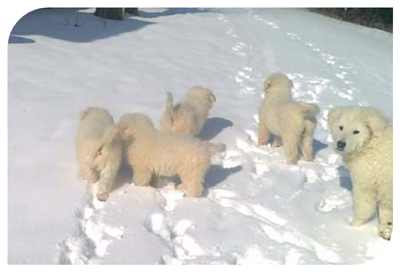
|
|
Pack of “ Jacopone di Todi’”s puppies in a moment of freedom in the snowy roads that skirt the breeding farm woods
|
|
|
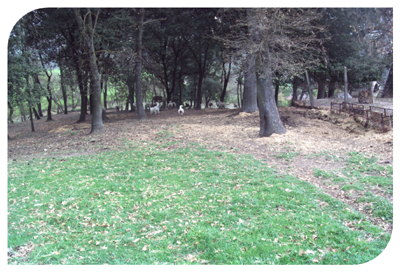
|
|
“Jacopne di Todi”’s puppies in freedom and working in the pasturing woods of the breeding farm. In this picture you can find the rare role of leading dog of the pma
|
|
To be able to provide, in a few words, the history and the present professional breeding process of "Jacopone of Todi" would be difficult and restrictive if this did not include a profound knowing of the Pastore Maremmano , and as often reminded, if one was to fall into oblivion the essence of the system bucolic agro-pastoral from which our adored breed took origin. In the book " Pastori Italiani( italian sheepdogs) published by De Vecchi Editore, written , amongst other things, in regards to the Behaviour and Aptitude section of the Pastore Maremmano - Abbruzzese: " In his habitat he is very frugal and appreciates the traditional whey and bran soup, a little meat , some vegetables, a piece of firm bread. He prefers to live in the open both in winter and in summer, in absolute liberty and independence.If he is placed in custody of a house he chooses as resting place the external threshold of the house. If he is placed to protect the fleece or herd he chooses a place on a higher level of the animals in order to make sure he has them all at his eyesight and under control,on the most exposed and ventilated area, or on the ridges. He has no problems with the rain, which he in fact appreciates as it keeps his fur clean. He loves snow with which he plays and digs his resting place. he avoids with pleasure chains. In fact if he is tied to a chain this makes him grumpy, suspicious, wanting to bite and even dangerous. He is humble and submitted to a strict owner but fair and balanced. He stays willingly with children and protects them, he plays with them...". From this I make my moves when, back in the years that immediately followed the second world war, returning from the war front to Todi as a veterinary officer, I fell in love and I determined to create , on a hill next to Todi headquarters place of fixed passage and resting place of transhumance sheep from the Appenine mountains to the clearing of the Tuscan swamps, a bucolic agro-pastoral system where the Maremma-Abruzzese Shepherd could have a more harmonious development. THey were difficult years of desperation and poverty, but due to this situation( where the italic had a profound value), during the resting time of these pastures, offering good food and decent accommodation to their drovers, year after year I managed to earn their trust in breeding sheep dogs significantly more typical. and sometimes, the more affectionate shepherds ( I remember each and every one of their names such was sincere our friendship) in order to repay me for the favour of offering them a refreshing break after days and days of hard work and rough nights spent, they would give me the most precious thing to them: their most beautiful and magnificent Maremma-Abruzzese Shepherd....
|
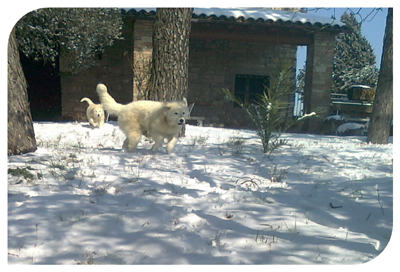
|
|
Jacopone di Todi puppies playing in the freezing cold winter in the park next door from the Prof.Simoni residence towards the breeding farm
|
|
|

|
|
Prof.Simoni’s daughter Simonetta posing with plurich.Vispa of Jacopne da Todi in the grassy kennels of the breeding farm connected to the wooded areas and pastures
|
|
Years go by, the sixties are close, the economic boom with its progress starting to be felt, and with my first car I started to travel also in all the centre of Italy to refine even more my selection of the breed which was based more and more on a scientific bases and no longer solely missal. In those years I dedicated myself mainly on the cure for Maremmani Shepherd dogs of the Corsini Princes’ Family. I established a very close relationship with Lady Anna and Don Tommaso Corsini with whom I gave my veterinary medical assistance for their splendid Maremmani Shepherd dogs especially in the Casigliano, Sismano, Salviano and Titignano estate. More years go by (the 70’/80’s arrive) my interest for the breed grows more and more, and (with too much insistence) I become a means of study from America to England of the “breeding system” and of my experience that I manifest in many of my books (like the one quoted) and scientific magazines. Especially in USA, where the shepherding takes place in large spaces, in those 70’s and 80’s there was a rediscovery of this type of dog and an aimed introduction under the guide of two state experimental centres created purposely to reduce the attacking of the fleece, especially hit by the elevated density of the coyote. Many studies have been carried out in regards to the pma, especially by the Coppingers… I still remember the camouflaged positions situated in the forestal area used as a sheep pasture of my breeding farm, I remember nights at the bivouac studying every single detail in regards to the behavioural reactions of defense of the pma. After an accurate fact finding investigation on shepherd dogs used in the old world ( Europe and Asia Minor) 6 breeds were chosen: Ours, Pyrenean Mountain, Komodor, Kuvacz, Akbasc, Char Planinatz. After further experiments the pma was: absence of agressiveness in regards to the fleece), Vigilant( the perseverance with which the dog remains guarding the fleece without ever going far) protection ( ability to prevent an attack with implementation of various aggressive behaviours of which barking, chasing and fighting). 79% of the fleece who had previously, frequently had problems of predation, with the pma, reduced considerably and 33% eliminated this problem forever. It was in fact at the end of these years that, due to the enthusiasm of the cognitive results that came from the studies and experiments carried out I determined in a scientific approach (which I will explain further on) on the breeding system. We arrived to the 90’s in the temporary period, I am shouldered by my family (especially by my daughter Simonetta and my grandson Jacopo to whom I will entrust my trust) and to whom I delegate the practical approach management leaving to myself all the selection and health aspects.
|
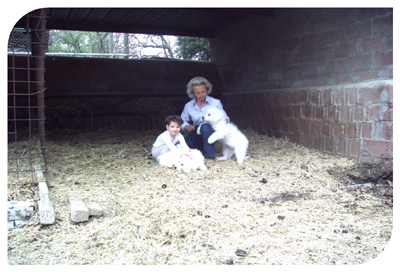
|
|
The daughter Simonetta with her granddaughter playing with the Jacopone da Todi puppies in the sheep’s resting pen
|
|
|
|
Finding myself more time, I dedicate my time on the deepening of all the canine doctrinal aspects, publishing books and reviews where I reverse my experience and try to clarify, from a scientific point of view and objective at the same time, with my doctrinal contribution, debates of the most various aspects (from the history of the name to the character standard) of the national and international canine. Too often unfortunately in regards to these debates I have found superficiality, lack of professionality experience and targets, worsened every now and then by a profit. There are now thousands of pma, with “di Jacopone da Todi” posted on them, who have won and who still excel in every national and international canine show and who will today and in the future maintain unchanged and enlivened not only the original structural and morphologic structure (that of which – too often neglected – I consider as another fundamental aspect and of utmost importance, especially for a dog of gigantic dimension and of superhuman strength…) also the character and behaviour aspect.
|
|
|
|
|
|
|
From a pure scientific system to blend with the original pastoral phase
|

|
|
The external play areas of the breeding farm while they shyly come out of their stall
|
|
|
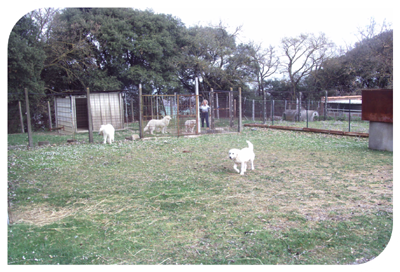
|
|
Prof.Simoni’s daughter Simonetta Todi in the grassy kennels of the breeding farm connected to the wooded areas and pastures. You can see the back side of the shhep pen
|
|
As we were saying, the “Jacopone da Todi” breeding system has been through basically 3 phases: 1) the agro-pastoral phase, where, being situated on the hill, breeding farm base, along the ancient cattle tracks where the flocks go through from the Appenines to the maremme , where the breed selection arose. 2) the purely scientific phase, and 3) the current phase” the breeding systemof Jacopone di Todi”which represents the evolution of the second phase, a “breakthrough “ of thescientific system of which I will now explain. The present standard breeding in fact, though necessary for the purposes of a healthy and balanced morphological character development of the dog , they are not sufficient for the pma; the overall conception of a kennel in order to include all the essential elements and be considered a model of perfection from a scientific point of view, must take into consideration many constructional elements and must have: pens that guarantee protection from bad weather with an adjoining courtyard allowing exercise( together with the recreational area) semi-covered courtyard where there is an area that protects from sun and rain inside every pen, evacuation of the liquids obtained by the reversal pendance in the pen / courtyard separation. Water and food protected from bad weather and contamination, direction of prevailing winds. The overall conception of a kennel must also consider strict separation of the more sensitive dogs (female pregnant dogs, puppies) from the others. An accurate study of spaces presupposes therefore the arrangement of diversified and suitable spaces for the various physiological stages (birth, growth, keeping, pregnancy, lactation, elderly dogs, sick dogs). The physical comfort of the dogs is an essential component for their well-being and for the running of the breeding farm. The British council, in regards to the well-being of the animals, consider in order to guarantee the good health of the dogs five types of liberty: 1) the freedom to live without hunger or thirst, 2) freedom to live without awkward situations, 3) freedom to live without wounds, pain or illnesses, 4) freedom to express normal behaviour depending on the various characteristics of the breed or species, 5) freedom to live without fear or stress. The expert and scholarly German colleague “Dantzer” in 1991 defined the stress being linked in regards to captivity as an “ensemble of stress that goes beyond the individual who receives’ ability to tollerate”… The research carried out for the well-being of dogs in community has always represented one of the basics for the development of the professional breeding farms of the future. All this is “Jacopone da Todi”: 21 accommodations with 7 leisure external areas, 4 breeding areas, 8 external summer kennels on territory connected to the wooded areas,10 winter kennels, 3 quarantine kennels , local dressing area, kitchen area, local infirmary.
|
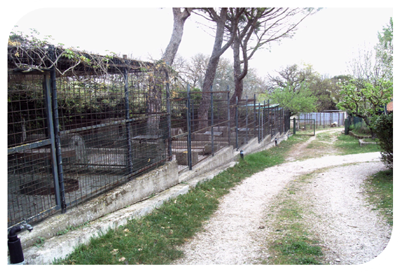
|
|
The winter kennels of the breeding farm and in the distance the summer grassy kennels in the south-west area of the breeding farm least exosed to the cold windy flows from the north
|
|
|

|
|
This is the pma dog , this is his pastoral world from where he originated! Never, approaching characteristically this wonderful Italian breed but we forget this! Never, choosing this breed , must a breeder forget the origins
|
|
The “Jacopone da Todi” breeding farm although is also much more than an application of the most modern breeding techniques on a scientific base inasmuch while not disregarding them, adds the fundamental and essential aspect for the pma: the natural environment, the habitat in which the dog was born and in which it develops the characterial and morphologic harmony. In fact the deepest doctrinal studies aimed for the improvement of the dogs’ environment in the breeding farms, too often disregard that each community is unique and various depending on the physical layout of the place offered, of the geographical layout, of the climatic context, of its history, of the financial and human possibilities that the breeder has. Therefore to obviate this, scientists aspire to take care of the dog world, the should have more possibilities to develop fruitful collaborations with the professional breeding farms, in order to be able to consider that every dog has a character that depends from his genetic background and from its experiences had during his growing course. It is this thread after the second world war goes through the whole history of our breeding farm: the pma must live in his world, must be free to run in the woods and fields, must be free to demonstrate his natural instinct to protect the flock to then also be able to adapt to the property, it must be free to feed on natural soup of serum and milk, little meat and a bit of farm bread, it must be free to live in its natural habitat. Any scientific conception, we repeat, even if necessary, must never leave aside, for whom breed pma, from the reproduction of his world, if we don’t desire that this marvellous Italian breed becomes another or worse a negation of itself. It is in fact for this that the “Jacopone da Todi” professional breeding farm is a part of the agro pastoral contest from which it has originated, and it is for this reason our pens are connected to a ten hectare wood area grassland where our dogs can go, reproduce and, living in freedom, conserve their real character and their real typical standard. All this is “Jacopone da Todi”.
|
|
|
Franco Simoni
|
|
|
|